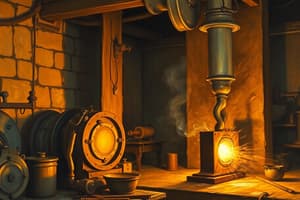Podcast
Questions and Answers
What is the purpose of core prints in the pattern?
What is the purpose of core prints in the pattern?
- To hold the pattern in place
- To align the pattern plate
- To create the imprint on the mold
- To hold the core in place (correct)
What is the function of the flask in the casting process?
What is the function of the flask in the casting process?
- To ram the sand into the mold (correct)
- To create the mold cavity
- To hold the pattern plate in place
- To melt the metal
What is the purpose of aligning pins in the pattern plate?
What is the purpose of aligning pins in the pattern plate?
- To hold the core in place
- To create the mold cavity
- To melt the metal
- To align the pattern plate with the flask (correct)
What is the term for the process of applying pressure to the mold to counteract buoyant forces?
What is the term for the process of applying pressure to the mold to counteract buoyant forces?
What is the purpose of the cope and drag in the casting process?
What is the purpose of the cope and drag in the casting process?
What is the term for the process of creating the mold cavity?
What is the term for the process of creating the mold cavity?
What is the function of the sprue and risers in the casting process?
What is the function of the sprue and risers in the casting process?
What is the purpose of heat treating the casting?
What is the purpose of heat treating the casting?
What is the term for the imprint left on the mold by the pattern?
What is the term for the imprint left on the mold by the pattern?
What is the purpose of removing the sprue and risers from the casting?
What is the purpose of removing the sprue and risers from the casting?
Flashcards are hidden until you start studying
Study Notes
Molds and Mold Making
- To form a mold cavity, molding sand is compacted around a pattern in a flask using various methods, including hand ramming and machine-based packing.
- The quality of a sand mold is determined by several factors:
- Strength: the ability to maintain its shape and resist erosion caused by molten metal flow.
- Permeability: the capacity to allow hot air and gases to pass through the voids in the sand.
- Thermal stability: the ability to resist cracking and buckling upon contact with molten metal.
- Collapsibility: the ability to give way and allow the casting to shrink without cracking.
- Reusability: the ability to reuse the sand from a broken mold to make other molds.
Types of Sand Molds
- Green-sand molds: made of a mixture of sand, clay, and water, and possess sufficient strength, good collapsibility, good permeability, and good reusability.
- Dry-sand molds: made using organic binders, baked in an oven, and provide better dimensional control, but are more expensive and have a lower production rate.
- Skin-dried molds: combine the advantages of dry-sand molds, where the surface of a green-sand mold is dried to a depth of 10-25 mm, using special bonding materials.
The Casting Operation
- The casting process involves pouring, solidification, and cooling of the cast part.
- The gating and riser system must be designed to deliver liquid metal into the cavity and provide for a sufficient reservoir of molten metal during solidification shrinkage.
- Air and gases must be allowed to escape during the casting process.
- After solidification and cooling, the sand mold is broken away from the casting, and the part is cleaned and retrieved.
Steps in the Casting Process
- Place a pattern in sand to create a mold.
- Incorporate the pattern and sand in a gating system, and remove the pattern.
- Fill the mold cavity with molten metal.
- Allow the metal to cool.
- Break away the sand mold and remove the casting.
Sequence of Operations in Sand Casting
- A mechanical drawing of the part is used to generate a design for the pattern.
- Patterns are mounted on plates equipped with pins for alignment.
- Core boxes produce core halves, which are pasted together.
- The cope and drag halves of the mold are assembled, and the core is set in place.
- The mold is closed, and the metal is poured into the mold.
- After solidification, the casting is removed from the mold, and the sprue and risers are cut off and recycled.
Studying That Suits You
Use AI to generate personalized quizzes and flashcards to suit your learning preferences.




